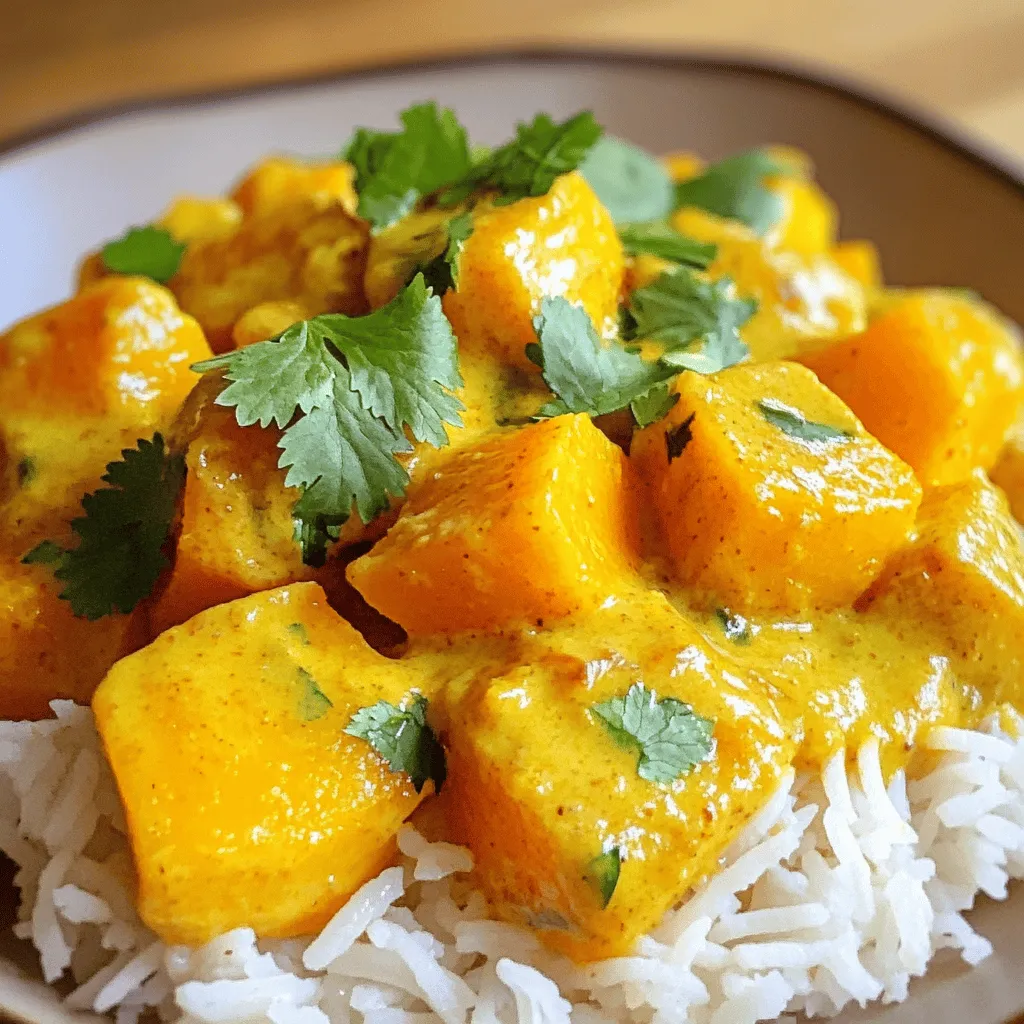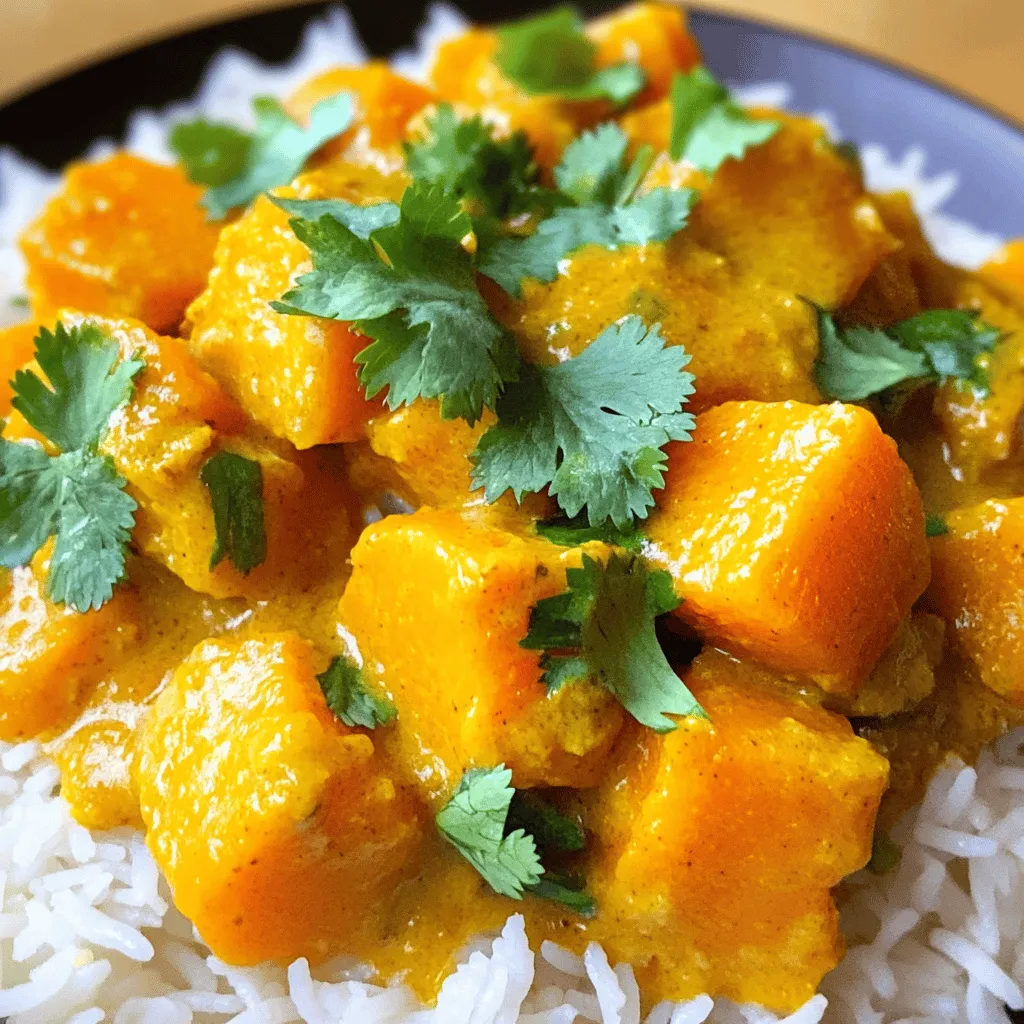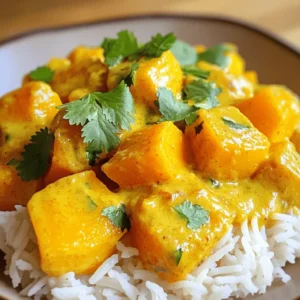Looking for a dish that warms the soul and excites the taste buds? Coconut Curry Butternut Squash is the answer! This creamy, flavorful delight combines the earthy sweetness of butternut squash with rich coconut milk and spices. It’s perfect for dinner or meal prep. Join me as I share how to make this comforting dish, from selecting the best ingredients to creative serving ideas. Time to stir up some magic in your kitchen!

Ingredients
List of Ingredients
– 1 medium butternut squash, peeled and diced into bite-sized cubes
– 1 can (400 ml) coconut milk
– 2 tablespoons red curry paste
– 1 medium onion, finely chopped
– 3 cloves garlic, minced
– 1 tablespoon fresh ginger, grated
– 1 tablespoon olive oil
– 2 cups vegetable broth or water
– 1 tablespoon soy sauce
– 1 tablespoon brown sugar (adjust to taste)
– Salt, to taste
– Fresh cilantro leaves, for garnish
– Cooked jasmine rice or quinoa, for serving
For those with special diets, you can use:
– Thai green curry paste instead of red for less spice.
– Coconut cream for a richer flavor.
– Tamari instead of soy sauce for gluten-free needs.
Ingredient Selection Tips
Choosing the best butternut squash is key. Look for squash that feels heavy for its size. The skin should be smooth and dull, not shiny. Avoid any with soft spots or blemishes.
For coconut milk, I recommend using brands like Aroy-D or Thai Kitchen. These brands have creamy texture and rich flavor. Check if they use natural ingredients without additives.
Tools and Equipment Needed
You will need some essential tools to prepare this dish:
– A sharp knife for cutting the squash.
– A cutting board to protect your counters.
– A large pot for sautéing and simmering.
– A wooden spoon or spatula for stirring.
For cookware, I suggest using a heavy-bottomed pot. This helps heat evenly and prevents burning. A lid is also important to cover the pot while simmering.
Step-by-Step Instructions
Preparation Steps
Start by peeling the butternut squash. Use a vegetable peeler for this task. Cut the squash in half and scoop out the seeds. Dice the squash into bite-sized cubes. Aim for uniform pieces to ensure even cooking.
Next, chop the onion finely. This helps it cook faster. Heat olive oil in a large pot over medium heat. Add the chopped onion and sauté it for about five minutes. You want the onion to become soft and translucent.
Now, add minced garlic and grated ginger. Cook them for one minute. This will release their strong flavors and aromas.
Cooking Process
Add the diced butternut squash to the pot. Stir it well with the onion mix. Sauté for five minutes until the squash starts to soften.
Now, it’s time to add the red curry paste. Stir it in until the squash is well coated. This will give the dish a vibrant flavor.
Pour in the vegetable broth and coconut milk. Mix everything together. Raise the heat and bring it to a gentle simmer.
Next, add soy sauce and brown sugar. Stir until the sugar dissolves. Cover the pot and let it simmer for about 20 to 25 minutes. The squash should be tender when you pierce it with a fork.
For a creamy texture, remove the pot from heat. Allow it to cool for a few minutes. Then, use an immersion blender to puree the curry until smooth. You can also leave it chunky if you prefer.
Serving Suggestions
Serve the coconut curry butternut squash over cooked jasmine rice or quinoa. This adds a nice base to the dish.
For a creative touch, use deep bowls. Drizzle a bit of extra coconut milk on top before garnishing. Finish with fresh cilantro leaves for color and freshness. Enjoy this comforting dish!
Tips & Tricks
Perfecting the Flavor
To adjust the seasoning of your coconut curry butternut squash, start with the basics. Taste as you cook. If you want more salt, add it slowly. For sweetness, add more brown sugar. Remember, every palate is different. You can also try adding a squeeze of lime for a fresh twist.
For the squash, achieving the right texture is key. You want it to be tender but not mushy. Cut the squash into even cubes. This helps it cook evenly. Sautéing for about five minutes will give it a nice start. Then simmer until it’s soft enough to pierce with a fork.
Quick Cooking Hacks
Keep your prep time short with a few smart tricks. Use pre-cut butternut squash if you’re in a hurry. This saves time on peeling and dicing. Also, chop your onion and garlic while the oil heats. This way, your pot is ready when you are.
Meal prepping this dish is easy. Make a big batch and store it in containers. It stays fresh for a few days. You can enjoy it for lunch or dinner throughout the week. Just warm it up when you’re ready to eat.
Handling Leftovers
Leftover curry can shine in new ways. You can use it in wraps or on baked potatoes. It also works well in soups or stews. Just mix it with some broth for a delicious meal.
When reheating, avoid the microwave if possible. Use a pot on low heat instead. This keeps the flavors intact. Stir often to make sure it warms evenly. Enjoy your tasty leftovers without losing that cozy flavor!

Variations
Dietary Options
This dish is easy to adapt for different diets. To make it vegan, use vegetable broth and ensure your red curry paste is free of fish sauce. For gluten-free needs, simply choose a gluten-free soy sauce or tamari.
If you want to add protein, consider these options:
– Chickpeas: They add a creamy texture.
– Tofu: Firm tofu works well when cubed and sautéed.
– Lentils: Cooked lentils blend nicely into the flavors.
Flavor Adjustments
You can change the spice level to fit your taste. For a milder curry, reduce the red curry paste. Add more coconut milk for creaminess. If you like heat, sprinkle in some chili flakes or fresh chili peppers.
Adding extra veggies boosts nutrition. Try:
– Spinach: Stir it in during the last few minutes.
– Bell Peppers: These add crunch and color.
– Carrots: They add sweetness and texture.
Cultural Twists
Curry comes in many styles from around the world. You can explore these variations:
– Thai Curry: Use different curry pastes like green or yellow.
– Indian Curry: Try adding garam masala or turmeric.
For regional spices, consider:
– Cumin: It adds warmth and depth.
– Coriander: It gives a fresh note.
– Cardamom: A pinch can add a lovely aroma.
Storage Info
Storing Leftovers
To keep your coconut curry butternut squash fresh, store it in the fridge. Place the curry in an airtight container. This helps to keep the flavors intact. It will stay good for about 3-5 days. If you want to store it longer, freezing is a great option. Just pour the curry into a freezer-safe container. Leave some space at the top for expansion. Label it with the date, and it will last up to 3 months.
Reusing Ingredients
Leftover butternut squash is versatile. You can mash it for a side dish or add it to soups. Coconut milk can be used in smoothies or baking. When storing, use glass containers. They keep food fresh and are easy to clean. Make sure the containers are airtight to avoid any spills.
Shelf Life
In the fridge, your coconut curry butternut squash will last about 3-5 days. After that, it’s best to check for spoilage. Signs of spoilage include a sour smell or mold. If you see any of these, it’s time to toss it out. Always trust your senses when it comes to food safety.
FAQs
Common Questions
What can I substitute for red curry paste?
You can use green curry paste or yellow curry paste. Each brings a different flavor but works well. You can also create a blend of spices like cumin, coriander, and turmeric for a homemade option.
How spicy is coconut curry butternut squash?
The dish has mild to moderate heat due to the red curry paste. If you want it spicier, add more paste or chili flakes. If you prefer less heat, start with a small amount of red curry paste.
Cooking & Preparation Questions
Can I make this dish in advance?
Yes, you can prepare it a day ahead. Store it in an airtight container in the fridge. Just reheat it on the stove when you are ready to serve.
How do I know when the butternut squash is cooked?
The squash is cooked when it is tender and easily pierced with a fork. It should be soft but not mushy.
Dietary & Ingredient Questions
Is this recipe gluten-free?
Yes, this recipe is gluten-free. Use gluten-free soy sauce if needed.
Can I use fresh coconut instead of canned coconut milk?
Yes, you can use fresh coconut. Blend the coconut meat with water and strain it to get coconut milk. It adds a fresh flavor to the dish.
Coconut Curry Butternut Squash is simple to make and full of flavor. We covered key ingredients, tips for picking squash, and the best tools for cooking. I shared step-by-step instructions and how to serve it. Don’t forget the quick cooking hacks to save time.
Experiment with variations to fit your diet and taste. Store leftovers wisely to enjoy later. Remember, cooking is about creativity. Enjoy making this delicious dish your own!

